The ASRock X399 Professional Gaming Motherboard Review: 10G For All
by E. Fylladitakis on July 5, 2018 8:00 AM EST- Posted in
- Motherboards
- AMD
- Gigabyte
- ASRock
- Asus
- 10GBase-T
- ThreadRipper
- X399
Visual Inspection
Even though the ASRock X399 Professional Gaming is targeted to gamers, its design is not as extravagant as we expected it to be. Perhaps the only thing that stands out in terms of aesthetics are the sharp, futuristic heatsinks. The two heatsinks that cool the processor's VRM circuitry are connected with a heatpipe but there is no extra fan for active cooling. The designer used black color for the PCB and plastics, and preserved the natural color of metal for all metallic parts, creating a nice visual antithesis. RGB lighting is present but limited to the area surrounding the chipset's heatsink, with headers for adding external 12V RGB LED strips. Note that this motherboard does not support RGBW or digital RGBW/UV LED products.
ASRock advertises the X399 Professional Gaming as having an 11-phase design. Actually, the motherboard has an 8-phase VRM circuit that uses the International Rectifier (Infineon) IR35201 digital controller, plus another 3-phase VRM circuit for the SoC. There is nothing irregular here, with ASRock going with a by-the-book approach and installing IR3555 MOSFET drivers (rated at 60A each) and 60A inductors. The IR35201 is a digital controller by International Rectifier that evenly distributes the load across the eight phases at all times, greatly improving the longevity of the components. The power circuitry is more powerful than that of less costly motherboards, potentially allowing for higher overclocks and, perhaps, compatibility with future versions of the Ryzen Threadripper processor.
The audio circuitry is interesting. It sports a Realtek ALC 1220 chipset as its core and an additional Texas Instruments NE5532 amplifier for the headphones. The main chipset is rated for a maximum rated sound-to-noise ratio (SNR) of 120dB. To help achieve that performance figure, ASRock physically isolated the right/left channel audio channels on individual layers and is using Nichicon audio-specific capacitors. The sound circuitry supports the Creative Sound Blaster Cinema 3 Software.
The layout of the ASRock X399 Professional Gaming generally is good but there are some questionable design choices. As expected, most of the internal headers have been placed across the bottom edge of the motherboard. From left to right, there are two front panel audio headers, one standard and one vertical, a COM port header, a header for a 12V RGB strip, a standard 4-pin fan header, a TPM header, an extra power LED/system speaker header, two headers for USB 2.0 ports, a small CMOS reset switch, a debugging LCD, one USB 3.1 Gen 1 header, two gold-colored power/reset buttons, and the system switch/LED header. There is a second USB 3.1 Gen 1 header to the right of the motherboard, right next to the ATX 24-pin power connector.
Oddly, ASRock installed a 6-pin PCIe connector on the lower right edge of the motherboard that serves as an additional power source. The use of an extra power connector is not strange on AMD X399 motherboards that support quad SLI but the choice of this particular connector is, as it would force users who want to use four graphics cards to use an adaptor on Molex connectors because mosts PSU will top out at eight PCIe connectors.
Eight SATA connectors can be seen to the lower right side of the motherboard, all facing rightwards. A U.2 PCIe ×4 connector is present right above the SATA connectors. The ASRock X399 Professional Gaming also has three M.2 PCIe ×4 slots and all three support drives up to 80 mm long - there are no slots that support 110 mm long drives on the ASRock X399 Professional Gaming. One of the slots supports the currently rare ultra-short 32 mm M.2 devices. Unlike with other manufacturers, none of the M.2 slots has any heatsinks. No PCI lanes are being shared between the three M.2 slots, meaning that they can all run at ×4 simultaneously. However, the U.2 slot shares its lanes with the third M.2 slot and will disable this slot entirely should a U.2 device is installed.
Another odd design choice, as shown below, is the placement of the CPU's EPS power connectors. The 8-pin and 4 pin 12V CPU connectors are placed at the top right and top left side of the motherboard respectively. ASRock advertises this as an advantage, as it creates a wider trace for the CPU's VRMs. The concept is technically sound from an engineering point of view but it also could create compatibility problems because several PSUs have both CPU 12V connectors on a single cable, meaning that an extension would be necessary to reach the second connector on the motherboard. A thicker copper layer would certainly produce better results but, since ASRock is already using a 2oz copper PCB, a thicker copper layer would greatly increase the motherboard's manufacturing cost. Another odd design choice is the placement of two fan headers between the CPU's socket and the first PCIe slot, where they will be practically inaccessible after a CPU heatsink and a graphics card are installed.
USB connectors dominate the rear panel of the ASRock X399 Professional Gaming. Starting from the top of the motherboard, we can see a small BIOS "flashback" switch, two USB 3.1 Gen 1 connectors and a PS/2 combo connector, two wireless antenna connectors, two USB 3.1 Gen 1 connectors, five gold-plated 3.5 mm audio jacks and one optical SPDIF connector, two USB 3.1 Gen 1 connectors and the red Aquantia 10Gbps NIC, another two USB 3.1 Gen 1 connectors and the first I211-AT NIC, and, finally, the two USB 3.1 Gen 2 10 Gbps connectors (one Type-A and one Type-C) and the second I211-AT NIC.


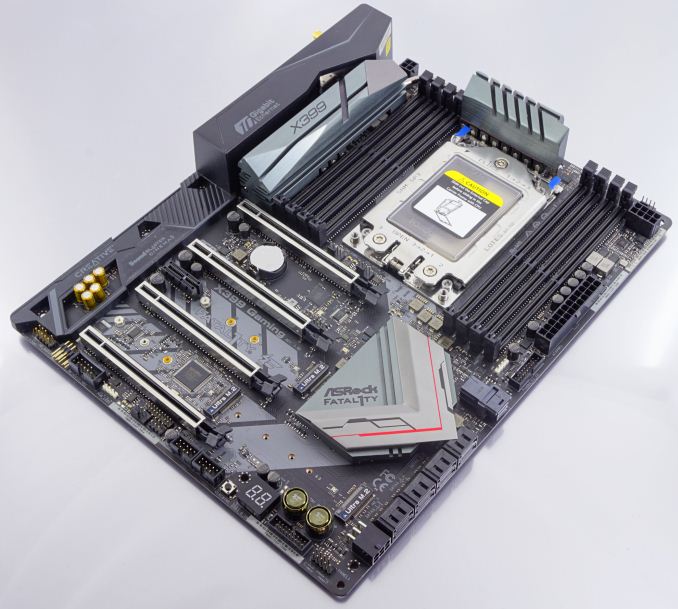
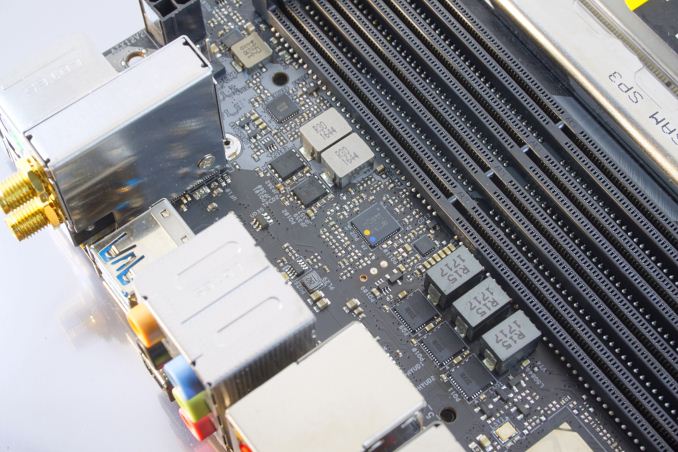
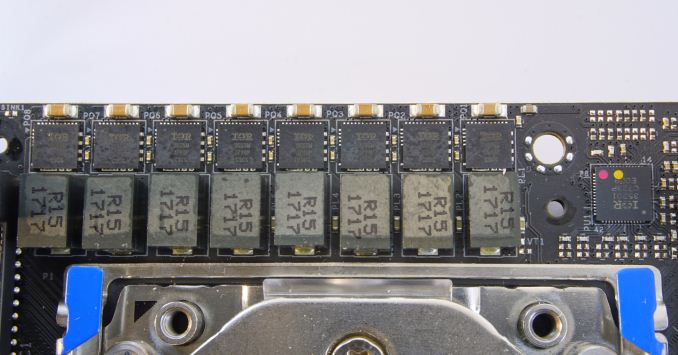
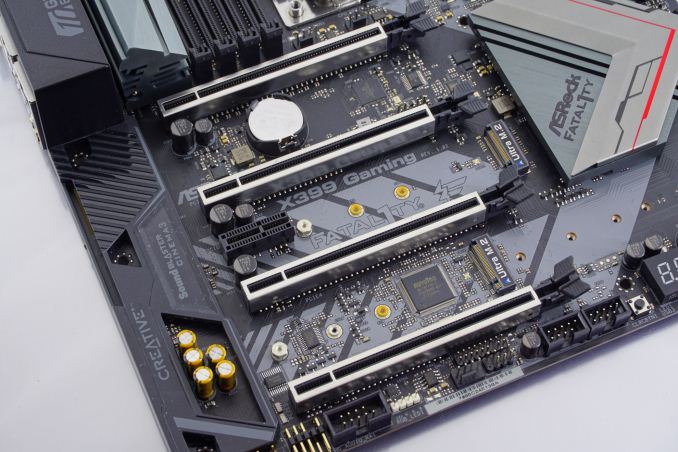

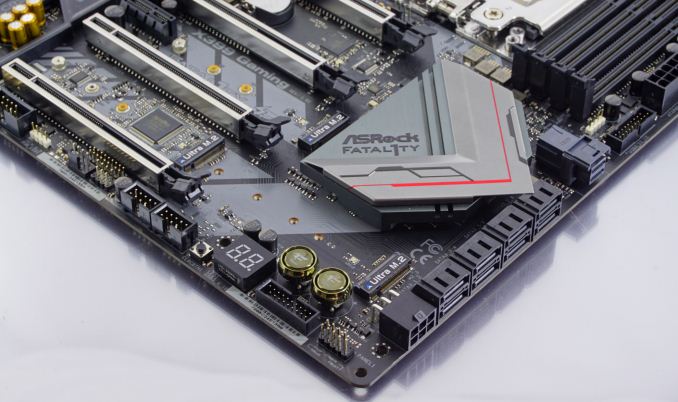
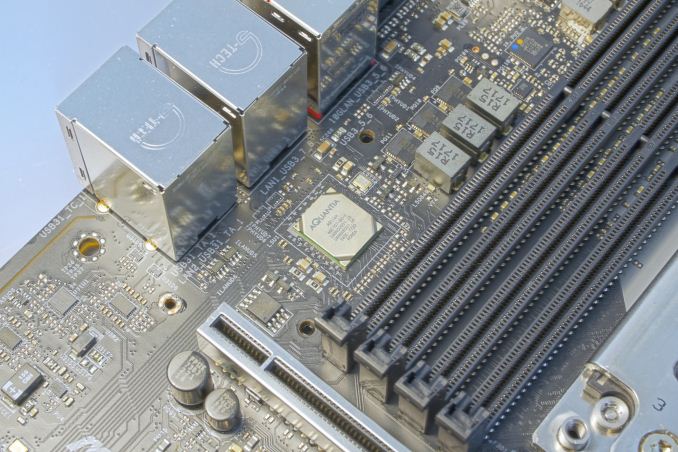
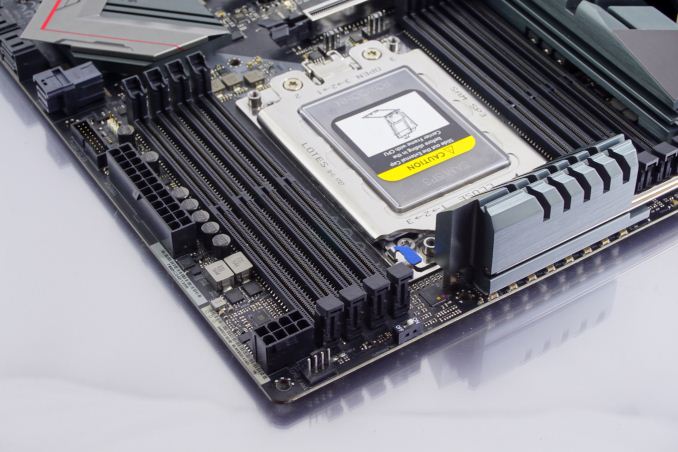
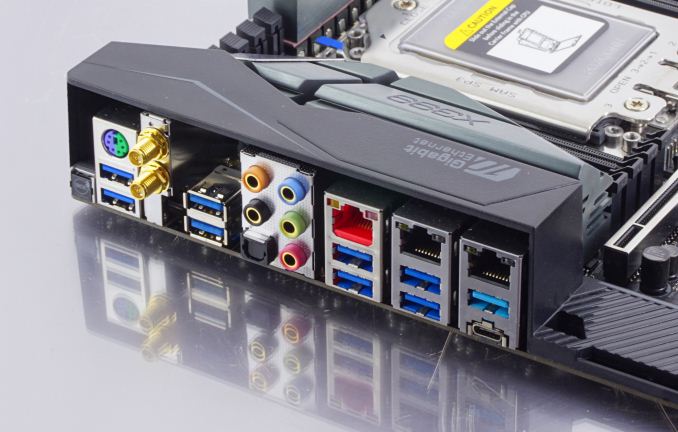








43 Comments
View All Comments
29a - Thursday, July 5, 2018 - link
The logical assumption for the Killer NIC love affair would be money.PeachNCream - Friday, July 6, 2018 - link
I'm not sure its about money. Anandtech has historically acted to avoid financial conflicts of interest and there's Purch oversight these days as well. It seems more of an interpersonal or friendship thing.It's in the comments of this article where AT's people met Rivet's people that seems like the starting point: https://www.anandtech.com/show/10679/rivet-network...
From there, it's pretty much been site-wide drum beating in every single review where a Killer NIC ends up in a product without data that backs it up, but we're badgered into thinking that because we're gamers we should have an ethernet boner over some OEM shoveling one of Rivet's rebranded NICs and pointless AOL floppy diskette style bloatware on us. I'm guessing it's just that friendships were formed and people kicked off a bromance during the office tour that's since influenced the tone at Anandtech. The part that really irks me is that we've been told before that we wouldn't understand how a Killer NIC works because the matter is too complex to explain...that's been in comments from editors too in the past when we've tried to extract some reason for the bias. I know it's possible to explain this to technically-savvy AT readers because there are articles that have tackled more complicated for that same audience. Comments from editors like those are a cop-out for never finding a way to actually show there's a measurable real world benefit that justifies why Rivet Networks even exists today beyond it providing the industry with a supposed premium ethernet and wireless brand since there's an fairly pointless up-market version of every other component. It's just a shame this happened because lots of us otherwise still believe that Anandtech is an otherwise good site with useful, in-depth articles. I just wish they'd either publish proof or turn the dial back a few notches on Killer NIC commentary.
PeachNCream - Thursday, July 5, 2018 - link
"The design of the X399 Professional Gaming is not in any way extravagant, as one would expect from a top-tier motherboard that is almost exclusively targeting gamers. On the contrary, the aesthetic design is subtle, yet elegant, focused on simple geometric shapes."I think it leans a lot closer to the obnoxious end of the spectrum than you do. Maybe when compared to a RGB-and-dragon/deformed bird-festooned gaming board that MSI or Gigabyte vomited up at a recent computer show it might look toned-down, but for an adult buyer, it this thing still has the stink of gamer man-child. It's only a notch or two away from the top of the volume dial thanks to someone at ASRock sticking "professional" on the box next to a has-been old guy's screen name in the hopes of catching a few workstation buyers.
Arbie - Thursday, July 5, 2018 - link
This IS understated compared to practically any other enthusiast board. In fact only the extra-pointy heatsink cover could even be called flash. "The stink of gamer man-child"?? You must go insane over the truly glitzy stuff.PeachNCream - Friday, July 6, 2018 - link
Since you missed it, here's where that was already noted: " Maybe when compared to a RGB-and-dragon/deformed bird-festooned gaming board that MSI or Gigabyte vomited up at a recent computer show it might look toned-down..."vailr - Thursday, July 5, 2018 - link
What's the status of Thunderbolt appearing on AMD motherboards?Since Intel released the Thunderbolt patents to anyone interested in using it, one would have thought it would be appearing on AMD motherboards by now. Maybe even on an AMD-based "modular Mac Pro 2019", according to some rumors on certain Mac-related web sites.
GreenReaper - Sunday, July 8, 2018 - link
I'm not sure if "released" means "licensed along with a covenant not to sue". Sometimes "free" isn't exactly free.kgardas - Thursday, July 5, 2018 - link
And does it support ECC UDIMMS or not? That is the question. W/o ECC it's really just yet another gaming board. With ECC supports one may see if it's possible to get rid of those silly LEDs and then give it a run...Fujikoma - Friday, July 6, 2018 - link
What is meant by 'comprehensive manual'? My ASRock mobo had an atrocious manual (minimalist at best). No downloadable/printable 'comprehensive manual'. There were even QR-codes that linked to nothing, meaning they still haven't written up what those options are and what they do per each firmware revision. I've ended up relying on support board postings to find out all the various nooks and crannies of the BIOS.Strunf - Friday, July 6, 2018 - link
"Gamers would most likely welcome the replacement of all three NICs with just one with proven gaming performance."Unlikely... a single NIC would make this board look cheap and not professional at all, it's professional gaming motherboard after all. 2 NICs are a minimum on this kind of price tag.
I would be interested to know where your "proven gaming performance" comes from cause from what I see there's virtually no difference in gaming performance between any NIC and one only comes ahead in very specific cases scenarios like Internet bandwidth limited and torrenting/streaming while playing.